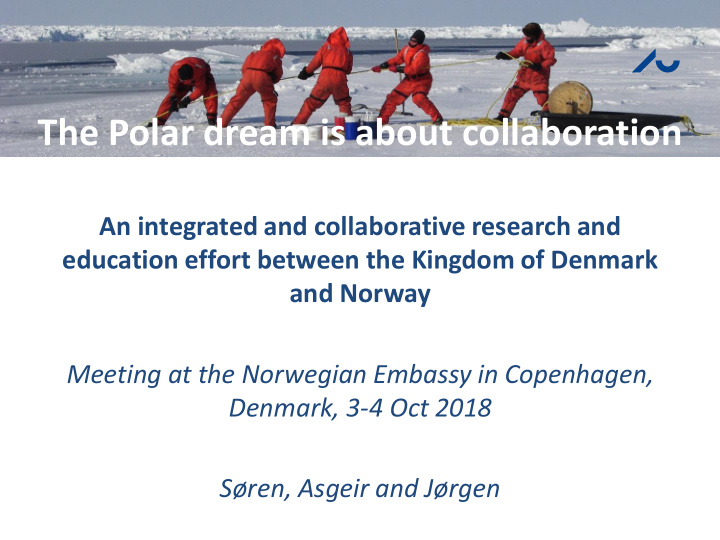



The Polar dream is about collaboration An integrated and collaborative research and education effort between the Kingdom of Denmark and Norway Meeting at the Norwegian Embassy in Copenhagen, Denmark, 3-4 Oct 2018 Søren, Asgeir and Jørgen
Eureka: Idea launched at Outreach Campaign June 2018 organized by UiT – The Arctic University of Norway
Partners • Aarhus University, Denmark • The Greenland Institute of Natural Resources • Havstovan, the Faeroe Islands • UiT - The Arctic University of Norway • Norwegian University of Science and Technology (NTNU) • The University Centre on Svalbard (UNIS) • REV Ocean
Other relevant partners • Bergen University • Copenhagen University • The Marine Institute, Iceland • Marin Research Institute, Norway • Technical University Denmark (DTU), Denmark • Norwegian Polar Institute • Kongsberg Group • SMB companies • Royal Greenland • DNV GL • Arctic Science Partnership • More
The Polar dream
Vision • The overarching vision is to develop an integrated environmental observation system that will enable a sustained, near real-time observation of the atmosphere, ice and ocean. at the scale of an entire ocean basin.
Why do we need an observing system? • Climate change is occurring rapidly and has cascading effects from physical changes to the environment, to ecosystems, and to social, economic and political conditions. • There is a need to understand larger scales in order to understand local conditions. • To operate safely and responsible there is a need for improved weather, ice hazard and environmental forecasting
What will we get from it? • Near real time high quality data with high coverage and resolution both in space and time, which will improve understanding of a data poor region. • This will deliver better weather, ice hazard and environmental forecasting. • It will deliver better advice for fisheries and harvest enabling a sustainable economy. • It will provide vital basic variables for research projects and attract and increase collaboration between local, regional and international investigators.
Greenland Integrated Observing System (GIOS) http://www.isaaffik.org
Greenland Integrated Observing System (GIOS): A contribution to international Arctic research and development from the Kingdom of Denmark
Background • Strong climate gradient (N,S) along East Greenland • Little is known about E, W gradients • Need for upscaling of long-term measurements and from few monitoring sites to the Greenland scale • Need to link atmosphere-ice-land- ocean compartments and interactions • Time is ready for this adventure Rysgaard et al 2003, 35:301-312. Arctic, Antarctic and Alpine Research
Greenland land-based stations and weather iClimate stations • Large areas with few or missing data, especially on East Greenland ARC • Let’s use this meeting to identify: • Geographic focus areas along and across the ARC domain • Key parameters to measure (e.g. more E, W weather/ice/ocean stations • Key platforms for joint logistics and operations • How to upscale our results
Infrastructure Norway: Ships: Helmer Hanssen, Kronprins Haakon, Gunnerus, REV Robotic platforms by NTNU AUR and UAV Labs: 5 AUVs, 3 ROVs, 4 USV, 5-10 UAV, smallsats from 2021 Denmark: Ships: Dana, Lauge Koch Long-term monitoring programs: Zackenberg, Nuuk, Disko & St Nord, various moorings and autonomous platforms (drones, AUVs), Royal Greenland trawler instrumentation Greenland: Ships: Sanna, and new Paamiut Long-term fishery and oceanographic data series, monitoring programs, various moorings. Various research stations in Greenland Faroe Islands: Ships: Magnus Heinason Long-term fishery and oceanographic, nutrients data series, monitoring programs, various moorings.
NTNU & UiT The Arctic University of Norway: Integrated technology platforms for ocean space research Air: Penguin B fixed-wing UAV X8 fixed-wing UAV Hexa-copters Sea surface: Gunnerus (NTNU) Unmanned vessel – Jetyak (UiT) Unmanned vessel – 4 Otters (NTNU) Helmer Hanssen (UiT) Kronprins Haakon (UiT) Underwater: ROV Minerva ROV 30k AUV REMUS 100 at ROV SEABOTIX AUV Remus 100 Svalbard ROV Minerva HUGIN HUS 2 LAUVs
Integrated marine mapping and monitoring using ships and autonomous robotics solutions/platforms operating in space, air, surface and underwater
Next step – joint campaigns • Step 1 – coastal ecosystems – aligning existing data (ongoing). Joint publications review, in progress • Step 2 – Ships of opportunity – e.g. make LOI for Lauge Kock, new Pamiut, Sanna, REV • Step 3 – Dream cruise sections from coastal to open water – (preliminar sections, Dana, L. Kock ans small vessels have been made) • Step 4 – Dream synoptic campaign in 2021.
Next Step - Education • Mapping existing courses (Norway & Denmark/Greenland/Faroe Island) • MoU (UNIS-ARC) • Increase mobility between contries • Organize PhD summer schools in 2020
Next step - Funding • National – public and private • Scandinavia (NorForsk) • EU (new polar program). • ITN PhD network (proposal should be submitted spring 2020 – so students can join the 2021 campaign)
Recommend
More recommend